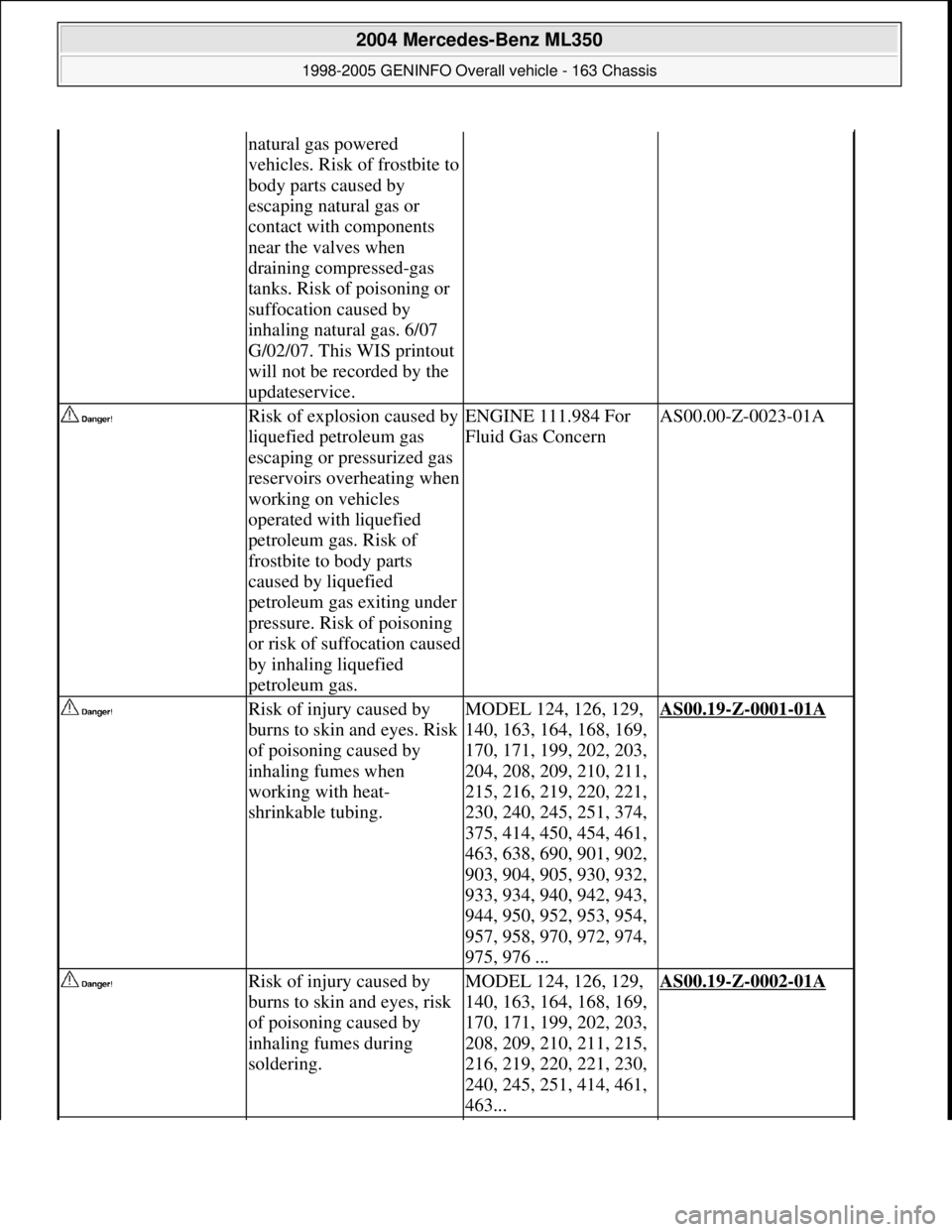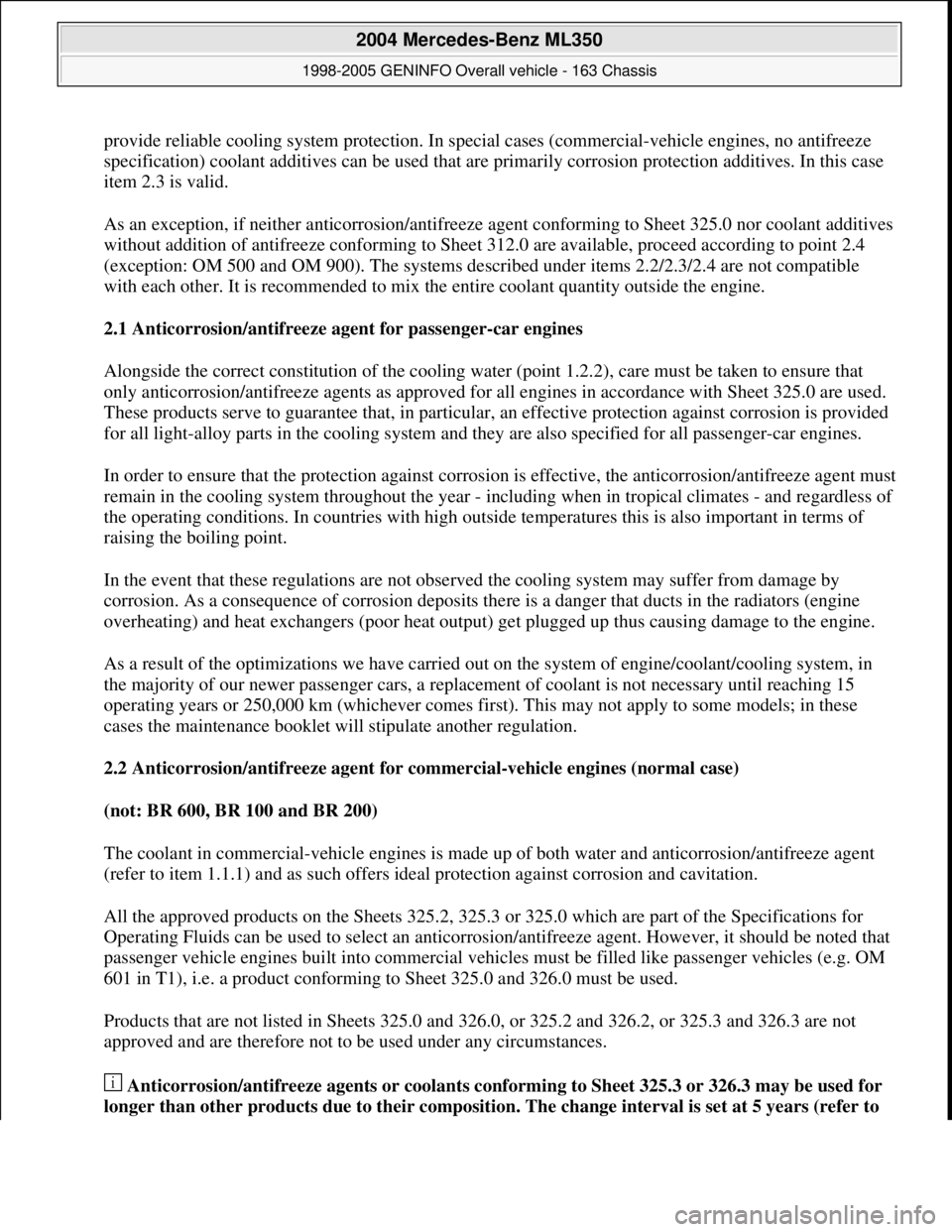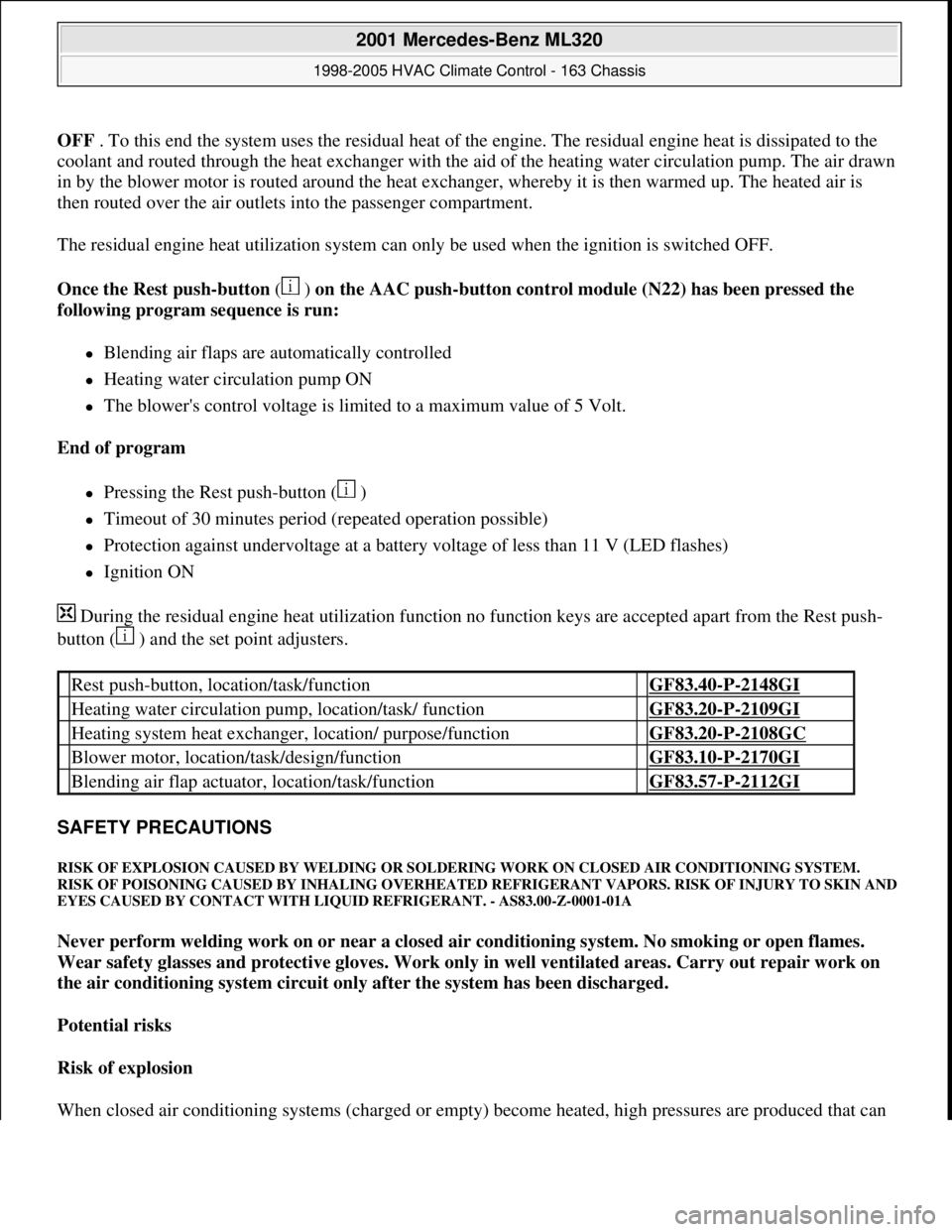1997 MERCEDES-BENZ ML350 engine overheat
[x] Cancel search: engine overheatPage 2174 of 4133

location/design/function113, 119, 137
Engine 120GF30.20-P-3010F
Anti-knock control function GF15.12-P-4024F
Transmission overload protection
functionwith automatic
transmissionGF07.61-P-4026F
Overheating/pinging protection
function GF07.61-P-4027F
Intake air temperature correction
function GF07.61-P-4028F
ME-SFI synchronizing fuel
injection and firing order function GF07.61-P-4009F
ME-SFI ignition system signal
assignmentEngine 104GF15.12-P-0001-02D
Engine 111GF15.12-P-0001-02G
Engine 112GF15.12-P-0001-02A
Engine 113GF15.12-P-0001-02B
Engine 119GF15.12-P-0001-02E
Engine 120GF15.12-P-0001-02F
Engine 137GF15.12-P-0001-02L
ME engine speed signal function GF07.61-P-3017F
ASR V control unit
location/task/design/functionwith code 471a
Model 129, 140, 202 as
of 6/94, 170, 208, 210GF42.40-P-4500A
ESP control unit location / task /
functionwith code 472a
Model 129 with engines
104, 119, 120
Model 140
Model 210 with engine
119GF42.45-P-4500A
with code 472a
Model 129 with engine
112, 113
Model 163 up to 8/02,
168, 215
Model 220 (except
220.08/18)
Model 202, 208 with
engine 112, 113
Model 210 with engine
111, 112, 113GF42.45-P-4500B
with code 472a
Model 170 with engines
111, 112
Model 202, 208 with
Engine 111
Model 203GF42.45-P-4500C
2001 Mercedes-Benz ML320
1998-2005 ENGINE Electrical System - Engine - 163 Chassis
me
Saturday, October 02, 2010 3:18:54 PMPage 20 © 2006 Mitchell Repair Information Company, LLC.
Page 2878 of 4133

running engine or drive
train.
Risk of injury. Moving parts
can pinch, crush or, in
extreme cases even sever
extremities.MODEL allAS00.00-Z-0009-01A
Risk of injury caused by
fingers being jammed or
pinched when removing,
installing or aligning hoods,
doors, trunk lid/rear-end
door or sliding roof.MODEL allAS00.00-Z-0011-01A
Risk of injury from fingers
being pinched or jammed
when working on gas struts
under pressureMODEL allAS00.00-Z-0012-01A
Risk of injury to skin or
eyes from hydraulic fluid
spraying out under pressure.
Risk of poisoning from
swallowing hydraulic fluid.MODEL allAS00.00-Z-0013-01A
Risk of injury. Rubber
mounts and bearing parts
can suddenly come loose
during installation/ removal
and shoot wildly through
the air.MODEL allAS00.00-Z-0014-01A
Risk of explosion from
pressurized spray cansMODEL 100, 107, 108,
109, 111, 112, 113, 114,
115, 116, 123, 124, 126,
129, 140, 163, 168, 170,
201, 202, 208, 210, 215,
216, 220, 221, 251 ...AS00.00-Z-0015-01A
Risk of poisoning caused by
inhaling vapors or
swallowing adhesive. Risk
of injury caused by glue
coming into contact with
skin and eyesMODEL 163, 169, 199,
204, 209, 211, 215, 216,
219, 221, 240, 245, 397,
461, 463, 613, 638, 639,
671, 684, 901, 902, 903,
904 ...AS00.00-Z-0016-01A
Injury hazard of cutting or
scraping on sharp vehicle
partsMODEL allAS00.00-Z-0017-01A
Risk of explosion caused by
escaping natural gas or an
overheated compressed-gas
tanks when working on MODEL 901, 902, 903,
904, 957.AS00.00-Z-0018-01A
2004 Mercedes-Benz ML350
1998-2005 GENINFO Overall vehicle - 163 Chassis
me
Saturday, October 02, 2010 3:47:48 PMPage 233 © 2006 Mitchell Repair Information Company, LLC.
Page 2879 of 4133

natural gas powered
vehicles. Risk of frostbite to
body parts caused by
escaping natural gas or
contact with components
near the valves when
draining compressed-gas
tanks. Risk of poisoning or
suffocation caused by
inhaling natural gas. 6/07
G/02/07. This WIS printout
will not be recorded by the
updateservice.
Risk of explosion caused by
liquefied petroleum gas
escaping or pressurized gas
reservoirs overheating when
working on vehicles
operated with liquefied
petroleum gas. Risk of
frostbite to body parts
caused by liquefied
petroleum gas exiting under
pressure. Risk of poisoning
or risk of suffocation caused
by inhaling liquefied
petroleum gas.ENGINE 111.984 For
Fluid Gas ConcernAS00.00-Z-0023-01A
Risk of injury caused by
burns to skin and eyes. Risk
of poisoning caused by
inhaling fumes when
working with heat-
shrinkable tubing.MODEL 124, 126, 129,
140, 163, 164, 168, 169,
170, 171, 199, 202, 203,
204, 208, 209, 210, 211,
215, 216, 219, 220, 221,
230, 240, 245, 251, 374,
375, 414, 450, 454, 461,
463, 638, 690, 901, 902,
903, 904, 905, 930, 932,
933, 934, 940, 942, 943,
944, 950, 952, 953, 954,
957, 958, 970, 972, 974,
975, 976 ...AS00.19-Z-0001-01A
Risk of injury caused by
burns to skin and eyes, risk
of poisoning caused by
inhaling fumes during
soldering.MODEL 124, 126, 129,
140, 163, 164, 168, 169,
170, 171, 199, 202, 203,
208, 209, 210, 211, 215,
216, 219, 220, 221, 230,
240, 245, 251, 414, 461,
463...AS00.19-Z-0002-01A
2004 Mercedes-Benz ML350
1998-2005 GENINFO Overall vehicle - 163 Chassis
me
Saturday, October 02, 2010 3:47:48 PMPage 234 © 2006 Mitchell Repair Information Company, LLC.
Page 3169 of 4133

provide reliable cooling system protection. In special cases (commercial-vehicle engines, no antifreeze
specification) coolant additives can be used that are primarily corrosion protection additives. In this case
item 2.3 is valid.
As an exception, if neither anticorrosion/antifreeze agent conforming to Sheet 325.0 nor coolant additives
without addition of antifreeze conforming to Sheet 312.0 are available, proceed according to point 2.4
(exception: OM 500 and OM 900). The systems described under items 2.2/2.3/2.4 are not compatible
with each other. It is recommended to mix the entire coolant quantity outside the engine.
2.1 Anticorrosion/antifreeze agent for passenger-car engines
Alongside the correct constitution of the cooling water (point 1.2.2), care must be taken to ensure that
only anticorrosion/antifreeze agents as approved for all engines in accordance with Sheet 325.0 are used.
These products serve to guarantee that, in particular, an effective protection against corrosion is provided
for all light-alloy parts in the cooling system and they are also specified for all passenger-car engines.
In order to ensure that the protection against corrosion is effective, the anticorrosion/antifreeze agent must
remain in the cooling system throughout the year - including when in tropical climates - and regardless of
the operating conditions. In countries with high outside temperatures this is also important in terms of
raising the boiling point.
In the event that these regulations are not observed the cooling system may suffer from damage by
corrosion. As a consequence of corrosion deposits there is a danger that ducts in the radiators (engine
overheating) and heat exchangers (poor heat output) get plugged up thus causing damage to the engine.
As a result of the optimizations we have carried out on the system of engine/coolant/cooling system, in
the majority of our newer passenger cars, a replacement of coolant is not necessary until reaching 15
operating years or 250,000 km (whichever comes first). This may not apply to some models; in these
cases the maintenance booklet will stipulate another regulation.
2.2 Anticorrosion/antifreeze agent for commercial-vehicle engines (normal case)
(not: BR 600, BR 100 and BR 200)
The coolant in commercial-vehicle engines is made up of both water and anticorrosion/antifreeze agent
(refer to item 1.1.1) and as such offers ideal protection against corrosion and cavitation.
All the approved products on the Sheets 325.2, 325.3 or 325.0 which are part of the Specifications for
Operating Fluids can be used to select an anticorrosion/antifreeze agent. However, it should be noted that
passenger vehicle engines built into commercial vehicles must be filled like passenger vehicles (e.g. OM
601 in T1), i.e. a product conforming to Sheet 325.0 and 326.0 must be used.
Products that are not listed in Sheets 325.0 and 326.0, or 325.2 and 326.2, or 325.3 and 326.3 are not
approved and are therefore not to be used under any circumstances.
Anticorrosion/antifreeze agents or coolants conforming to Sheet 325.3 or 326.3 may be used for
longer than other products due to their composition. The change interval is set at 5 years (refer to
2004 Mercedes-Benz ML350
1998-2005 GENINFO Overall vehicle - 163 Chassis
me
Saturday, October 02, 2010 3:47:57 PMPage 524 © 2006 Mitchell Repair Information Company, LLC.
Page 3397 of 4133

OFF . To this end the system uses the residual heat of the engine. The residual engine heat is dissipated to the
coolant and routed through the heat exchanger with the aid of the heating water circulation pump. The air drawn
in by the blower motor is routed around the heat exchanger, whereby it is then warmed up. The heated air is
then routed over the air outlets into the passenger compartment.
The residual engine heat utilization system can only be used when the ignition is switched OFF.
Once the Rest push-button ( ) on the AAC push-button control module (N22) has been pressed the
following program sequence is run:
Blending air flaps are automatically controlled
Heating water circulation pump ON
The blower's control voltage is limited to a maximum value of 5 Volt.
End of program
Pressing the Rest push-button ( )
Timeout of 30 minutes period (repeated operation possible)
Protection against undervoltage at a battery voltage of less than 11 V (LED flashes)
Ignition ON
During the residual engine heat utilization function no function keys are accepted apart from the Rest push-
button ( ) and the set point adjusters.
SAFETY PRECAUTIONS
RISK OF EXPLOSION CAUSED BY WELDING OR SOLDERING WORK ON CLOSED AIR CONDITIONING SYSTEM.
RISK OF POISONING CAUSED BY INHALING OVERHEATED REFRIGERANT VAPORS. RISK OF INJURY TO SKIN AND
EYES CAUSED BY CONTACT WITH LIQUID REFRIGERANT. - AS83.00-Z-0001-01A
Never perform welding work on or near a closed air conditioning system. No smoking or open flames.
Wear safety glasses and protective gloves. Work only in well ventilated areas. Carry out repair work on
the air conditioning system circuit only after the system has been discharged.
Potential risks
Risk of explosion
When closed air conditionin
g systems (charged or empty) become heated, high pressures are produced that can
Rest push-button, location/task/function GF83.40-P-2148GI
Heating water circulation pump, location/task/ function GF83.20-P-2109GI
Heating system heat exchanger, location/ purpose/function GF83.20-P-2108GC
Blower motor, location/task/design/function GF83.10-P-2170GI
Blending air flap actuator, location/task/function GF83.57-P-2112GI
2001 Mercedes-Benz ML320
1998-2005 HVAC Climate Control - 163 Chassis
me
Saturday, October 02, 2010 3:23:17 PMPage 153 © 2006 Mitchell Repair Information Company, LLC.
Page 3464 of 4133

Remove/install
Risk of injury to skin and eyes
suffering scalding from contact with
hot coolant spray. Risk of poisoning
from swallowing coolant.
Do not open cooling system unless coolant
temperature is below 90°C. Open cap slowly
and release the pressure. Do not pour
coolant into beverage bottles.
Wear protective gloves, protective clothing
and eye protection.
AS20.00-Z-
0001-01A
Risk of explosion from welding or
soldering work on closed air
conditioning system. Risk of
poisoning. Inhaling overheated
refrigerant vapors may be toxic. Risk
of injury from skin and eye contact
with liquid refrigerant.Do not carry out any welding work on the
closed air conditioning system or in the
surrounding area. No smoking or open
flames. Wear eye protection and protective
gloves. Work only in well ventilated areas.
Carry out repair work on the air
conditioning system circuit only after the
system has been discharged.
AS83.00-Z-
0001-01A
Procedures if air conditioning system
is damaged or leakingAll models
AH83.30-
N-0004-
01A
Protect air conditioning circuit and
components from moisture when
carrying out repair work
All models fitted with air conditioning
AH83.30-
N-0005-
01A
Notes on handling refrigerant R134aAll models fitted with air conditioning
AH83.30-
N-0003-
01A
1Drain coolant J Engine 112, 113.AR20.00-P-
1142HA
Engine 111.AR20.00-P-
1142HG
Engine 612.963.AR20.00-P-
1142M
2Unscrew coolant compensating
reservoir (1) on firewall Lay compensating reservoir to one side.
3Disconnect coolant delivery/return
hoses for heat exchanger (2) Remove hose clamps from coolant hoses.
4Discharge air conditioning system
Installation: Evacuate air conditioning,
refill and check for proper operation and
leaktightness.AR83.30-P-
1760GH
5Remove cover on expansion valve
(4)
6Remove nut (3) on expansion valve
(4) Replace self-locking nut.
*BA83.30-
P-1003-01B
7Disconnect refrigerant lines from
expansion valve Installation: Install new sealing rings
and moisten with compressor oil.
2001 Mercedes-Benz ML320
1998-2005 HVAC Climate Control - 163 Chassis
me
Saturday, October 02, 2010 3:23:19 PMPage 220 © 2006 Mitchell Repair Information Company, LLC.